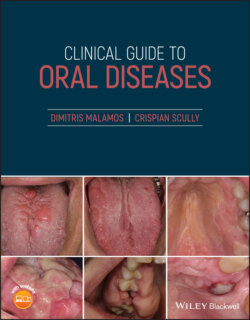Читать книгу Clinical Guide to Oral Diseases - Crispian Scully - Страница 28
Case 2.3
ОглавлениеCO: A 24‐year‐old woman presented with painful black‐dark brown scabs on both her lips.
HPC: The lip lesions were present for five days following an episode of painful ulcerations on her lips and mouth. The lesions were associated with sore throat, cervical lymphadenopathy, conjunctivitis, and areas of skin erythema. The ulcerations appeared one week after an upper respiratory infection, but similar episodes of skin and mouth lesions had been reported twice last year and resolved within three weeks without treatment.
PMH: Her medical history was unremarkable and no skin diseases, allergies, or drug use were recorded.
OE: The oral examination revealed black hemorrhagic scales covering the vermillion border of the upper, but mainly lower lip (Figure 2.3); these were easily removed leaving erythematous, bleeding areas underneath. Many superficial painful ulcers at the dorsum of the tongue, palate, and buccal mucosae were also seen and associated with bad breath and sialorrhea. The extra‐oral examination revealed mild cervical lymphadenitis, conjunctivitis, and erythematous patches on both her hands and legs combined with myalgia, fatigue but no fever.
Q1 What is the possible cause of her lip scabs?
1 Exfoliative cheilitis
2 Allergic cheilitis
3 Erythema multiforme
4 Drug‐induced cheilitis
5 Primary herpetic stomatitis
Answers:
1 No
2 No
3 Erythema multiforme (EM) is an acute recurrent disease that affects the skin, mouth, and other mucosae of young patients and is triggered by certain infections or drugs. This disease may present with a variety and severity of lesions, and has a tendency to be resolved through the years. The oral lesions that involve the mouth appear with a variety of ulcerations and erythema, while the lips are covered with hemorrhagic exudates as seen in this patient “Target” lesions are characteristically seen on the skin.
4 No
5 No
Comments: The lesions on the vermillion border of lips differ among EM, cheilitis (exfoliative; allergic; drug‐induced) or primary herpetic gingivostomatitis. Hemorrhagic, necrotic sloughs covering multiple painful ulcerations with minimal symptomatology were found in erythema multiforme, while small hyperkeratotic yellow scales which are easily removed by scrubbing the lips against the anterior teeth in young nervous women were seen in exfoliative cheilitis. In allergic cheilitis, the lips are swollen and erythematous with cracks, scales, and small ulcerations whenever they come in contact with allergens. Drug‐induced cheilitis shares clinical characteristics with allergic cheilitis and appears one to two weeks after drug uptake, while it is resolved soon after its withdrawal. In primary herpetic stomatitis the lip lesions are always accompanied with fever and general symptomatology.
Q2 Which of the infections below mostly precedes the onset of erythema multiforme?
1 Staphylococcal infection
2 Herpetic infection
3 Hemolytic streptococcal infection
4 Toxoplasmosis
5 Coccidioidomycosis
Answers:
1 No
2 Erythema multiforme is precipitated mostly by a previous Herpes virus infection in the majority (>70%) of cases. Both HSV 1 and 2, Epstein‐Barr, varicella zoster and cytomegalovirus DNA fragments trigger autoreactive T cells which via an inflammatory cascade release an interferon gamma that plays a crucial role in the development of EM lesions.
3 No
4 No
5 No
Comments: Bacterial, viral, fungal, or even parasitic infections have been involved in the pathogenesis of erythema multiforme. Bacterial infections such as diphtheria, streptococcal, legionellosis, leprosy, tuberculosis, or syphilis have been considered as triggering erythema multiforme. Infections from adenovirus, Coxsackie B5, enteroviruses, influenza, Herpes simplex virus (HSV), measles and mumps viruses or rare fungi such as Histoplasma, Coccidioides immitis and parasites such as Toxoplasma gondii and various species of Trichomonas often precede EM.
Q3 Which blood tests are abnormal in EM patients?
1 White blood account
2 Erythrocyte sedimentation rate (ESR)
3 Blood urea and creatinine
4 Electrolytes
5 Liver enzyme levels
Answers:
1 White blood count usually reveals moderate leukocytosis with atypical lymphocytes and lymphopenia but occasionally eosinophilia. Neutropenia is an indicator of bad prognosis.
2 ESR is an indicator of inflammation and can be elevated.
3 Blood urea and creatinine abnormalities are indicators of renal involvement and seen in severe cases with EM.
4 Electrolyte values are abnormal in severe cases of EM where fluid uptake could be extremely difficult, as it is hard for the patients to drink because of their mouth ulcerations.
5 No
Comments: None of these tests is pathognomonic for the disease and may be abnormal in severe cases. Specifically, the liver enzymes such as aspartate transaminase (AST), alanine transferase (ALT), alkaline phosphatase, and bilirubin are within the normal range in the majority but show an increased tendency in patients with EM due to acute hepatitis or due to antiviral treatment for HIV infection.
